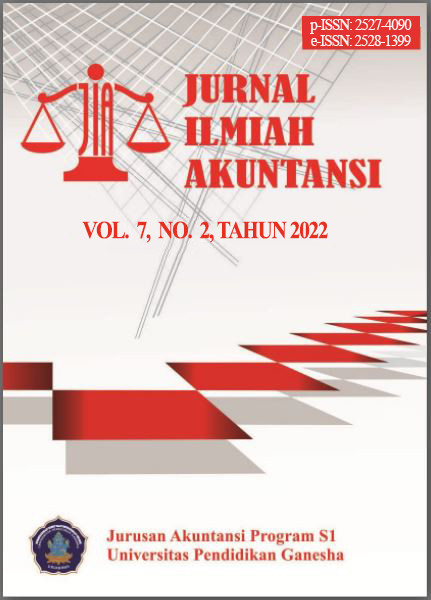The Evaluation of Internal Control System for Market Retribution Collection
DOI:
https://doi.org/10.23887/jia.v7i2.52842Keywords:
internal control system, market retribution, regional original incomeAbstract
To evaluate the internal control system for the collection of market levies, the Sumbawa Regency government cooperates with several agencies such as the Department of Transportation, the Department of Cooperatives, Industry and Trade, the Regional Finance and Revenue Management Agency and Bank Rakyat Indonesia with the aim of maximizing Regional Original Income through E-Retribution and avoiding budget leakage and assist the government in accurate economic planning and increase the circulation of money so that it is faster. This study uses a qualitative approach, data collection techniques through observation, interviews and documentation. The results show that the implementation of E-Retribution can make it easier for traders to pay market fees and can solve problems in managing user fees manually, because E-Retribution can be more effective, efficient and more transparent and accountable in increasing Regional Original Income.References
Albrecht, S. W. and C. Albrecht. 2004. Fraud Examination and Prevention. Australia: Thomson, South-Western.
Amanti, L. (2012). Pengaruh Good Corporate Governance Terhadap Nilai Perusahaan dengan Pengungkapan Corporate Sosial Responsibility sebagai Variabel Pemoderasi (Studi Kasus Pada Perusahaan Rokok Yang Terdaftar Di BEI). jurnal akuntansi UNESA, 1.
Baldric, Siregar. (2017). Akuntansi Sektor Publik (Akuntansi keuangan Pemerintah Daerah Berbasis Akrual). Yogyakarta: UPP STIM YKPN
Cahyadi, A., & Davianti, A. (2020). Pengaruh Faktor Internal Dan Eksternal Perusahaan Terhadap Praktik Manajemen Laba Di Perusahaan Publik Sektor Barang Konsumsi Periode 2014-2018. International Journal of Social Science and Business, 4(2), 172–181. https://doi.org/10.23887/ijssb.v4i2.24957
Chtourou, S. M., Bedard, J., & Courteau, L. (2001). Corporate governance and earnings management. SSRN Electronic Journal. https://doi.org/10.2139/ssrn.275053.
Daos, M., & Angi, Y. F. (2019). Penerapan Sistem Pengendalian Internal Dan Perlakuan Akuntansi Persediaan Barang Dagang Pada Ud. Angkasa Raya Kupang. Jurnal Akuntansi : Transparansi Dan Akuntabilitas, 7(1), 1–14. https://doi.org/10.35508/jak.v7i1.1298
Dewi, R. R., & Tarnia, T. (2019). Pengaruh Kinerja Keuangan Terhadap Nilai Perusahaan Dengan Good Corporate Governance Sebagai Variabel Moderasi. Jurnal Informasi, Perpajakan, Akuntansi, Dan Keuangan Publik, 6(2), 115–132. https://doi.org/10.25105/jipak.v6i2.4486
Dewi, Gusti Ayu Ketut. (2017). Pengaruh Moralitas Individu Dan Pengendalian Internal Pada Kecurangan Akuntansi (Studi Eksperimen pada Pemerintah Daerah Provinsi Bali). Jurnal Ilmiah Akuntansi. Vol. 1, No. 1, Hal: 77-92. DOI:10.23887/jia.v1i1.9984
Fatmawati, Y. (2018). Pengaruh Mekanisme Good Corporate Governance Terhadap Manajemen Laba. Jurnal Akuntansi, 6(1), 1–26.
Fernandes, N. G., & Ferreira, M. A. (2007). The Evolution of Earnings Management and Firm Valuation: A Cross-Country Analysis. In EFA 2007 Ljubljana Meetings Paper. https://doi.org/10.2139/ssrn.965636.
Gill, A., Biger, N., Mand, H. S., & Mathur, N. (2013). Earnings management, firm performance, and the value of indian manufacturing firms. International Research Journal of Finance and Economics, 116. https://scholarworks.waldenu.edu/sm_pubs/65/.
Guy, M, C. Wayne Alderman dan Alan J. Winters. (2002). Auditing Edisi kelima Jilid 1. Erlangga:Jakarta.
Kusumawati, V. C., Robiyanto, R., & Harijono, H. (2021). Profitability and Dividend Policy Affects Firm Value in The Infrastructure, Utility and Transportation Sector. International Journal of Social Science and Business, 5(1), 8–15. https://doi.org/10.23887/ijssb.v5i1.29822
Khumairoh, N. D., Sambharakreshna, Y., & Kompyurini, N. (2014). Pengaruh Kualitas Good Corporate Governance Terhadap Nilai Perusahaan Dengan Kinerja Keuangan Sebagai Variabel Intervening. JAFFA, 02(1), 51–60.
Lamala, W.Y., Silvia, R. & Wangka, N.M. (2018). Analisis Pengendalian Internal Terhadap Persediaan Barang Dagangan ( Studi Kasus Pada Toko 88 Tobelo ). UNIERA, 7(2). https://journal.stieken.ac.id/index.php/peta/article/view/378
Mardi. (2011). Sistem Informasi Akuntansi. Bogor: Ghalia Indonesia.
Maulana, Y.S. & Vistisa, I.F. (2018). Pengaruh Pengendalian Internal Persediaan Terhadap Efektivitas Pengelolaan Persediaan Produk Blockboard Pada PT Albasi Priangan Lestari. JIABI, 2(2). https://ejournal.unitomo.ac.id/index.php/niaga/article/download/1320/705
Morissan. (2012). Metode Penelitian Survei. Edisi Pertama 2012. Cetakan Ke 5, Oktober 2018. ISBN 978.602.8730. Penerbit: Prenada Media Group. (Divisi Kencana)/ Depok.
Sugiyono. (2011). Metodologi penelitian kuantitatif kualitatif dan R&D. Alfabeta.
Sugiyono. (2016). Metode Penelitian Kuantitatif, Kualitatif, R&D. Bandung: IKAPI.
Tannusa, M. & Arifulsyah, H. (2018). Analisis Pengendalian Internal Persediaan Barang Dagang Pada PT Pasar Buah 88. Jurnal Akuntansi Keuangan dan Bisnis,11(2). https://jurnal.pcr.ac.id/index.php/jakb/article/view/1709/928.
Yunistiyani, Vina & Afrizal, Tahar (2017). Corporate Social Responsibility Dan Agresivitas Pelaporan Keuangan Terhadap Agresivitas Pajak Dengan Good Corporate Governance Sebagai Pemoderasi. Jurnal Ilmiah Akuntansi. Vol. 2, No. 1, Hal: 01-31. Juni 2017. DOI:10.23887/jia.v2i1.9610
Downloads
Published
Issue
Section
License
JIA (Jurnal Ilmiah Akuntansi) is licensed under a Creative Commons Attribution-ShareAlike 4.0 International License
Authors who publish with this journal agree to the following terms:
- Authors retain copyright and grant the journal right of first publication with the work simultaneously licensed under a Creative Commons Attribution Attribution-NonCommercial-NoDerivatives 4.0 International License that allows others to share the work with an acknowledgment of the work's authorship and initial publication in this journal.
- Authors are able to enter into separate, additional contractual arrangements for the non-exclusive distribution of the journal's published version of the work (e.g., post it to an institutional repository or publish it in a book), with an acknowledgment of its initial publication in this journal.
- Authors are permitted and encouraged to post their work online (e.g., in institutional repositories or on their website) before and during the submission process, as it can lead to productive exchanges and earlier and greater citation of published work (See The Effect of Open Access).




1.png)



